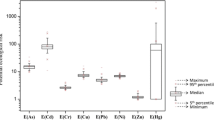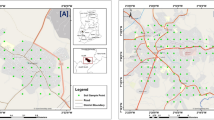Abstract
A soil survey was conducted in urban areas from five sites, including Beijing, Baotou, Datong, Fuyang, and Xiantao in China. The objective was to explore the most significant factors that may impact the bioaccessibility of heavy metals (Bio-HMs), including As, Cr, Cu, Pb, and Zn, in soils. Twenty to 30 composite soil samples were collected at each site. The various soil properties, including pH, particle size, Fe/Mn, and organic matter contents, were analyzed. The chemical operated forms of HMs in soils were measured by the Bureau of Reference (BCR) sequential extraction scheme, while the Bio-HMs were determined by the simple bioaccessibility extraction test (SBET) procedure. The concentrations of total heavy metals (T-HMs) in soils from different sites (cities) were in the range as As (5.69–9.86), Cr (77.42–230.20), Cu (15.68–36.54), Pb (14.12–58.93), and Zn (38.66–183.46) mg/kg. Cu and Pb had higher relative bioaccessibilities (48–70 %) than those of As and Cr (6–15 %), indicating higher health risks of the former than the latter two HMs. The Bio-HMs for various HMs were comparable to the first two or three combined BCR extracted fractions, with an exception of Cu, whose Bio-HMs were larger than the combined three BCR fractions, indicating that Cu was highly accessible in soils as compared with other HMs. Factor analysis showed that all variables, including soil property parameters and BCR extracted fractions, could be represented by three common factors extracted with higher than 0.5 loadings and ∼80 % cumulative contribution to the total variance. Among the three common factors, factor 1, containing mainly pH, texture, and Fe/Mn variables, and factor 3, containing mainly organic matter variable, could be attributed to geographical regions, while factor 2, containing mainly BCR extracted fractions, could be ascribed to relative bioaccessibility of HMs (R-Bio-HMs). Interactive mapping of the main factors and cluster analysis were consistent, which supported the “site gathering” of the soil sample pools, suggesting that the Bio-HMs in soils in different geographical localities were site dependent.




Similar content being viewed by others
References
Baig JA, Kazi TG, Arain MB, Shah AQ, Sarfraz RA, Afridi HI, Kandhro GA, Jamali MK, Khan S (2009) Arsenic fractionation in sediments of different origins using BCR sequential and single extraction methods. J Hazard Mater 167(1-3):745–751. doi:10.1016/j.jhazmat.2009.01.040
Basta N, Pantone D, Tabatabai M (1993) Path analysis of heavy metal adsorption by soil. Agron J 85(5):1054–1057
Bruder-Hubscher V, Lagarde F, Leroy M, Coughanowr C, Enguehard F (2002) Application of a sequential extraction procedure to study the release of elements from municipal solid waste incineration bottom ash. Anal Chim Acta 451(2):285–295
Caboche J, Denys S, Feidt C, Delalain P, Tack K, Rychen G (2010) Modelling Pb bioaccessibility in soils contaminated by mining and smelting activities. J Environ Sci Health, Part A: Tox Hazard Subst Environ Eng 45(10):1264–1274. doi:10.1080/10934529.2010.493818
Cheng H, Zhao C, Liu F, Yang K, Liu Y, Li M, Peng M, Li K, Nie H, Zhang Q, Cheng X, Ruan Q, Guo L, Li Y, Huo X (2013) Mercury drop trend in urban soils in Beijing, China, since 1987. J Geochem Explor 124:195–202. doi:10.1016/j.gexplo.2012.09.007
Chuan M, Shu G, Liu J (1996) Solubility of heavy metals in a contaminated soil: effects of redox potential and pH. Water Air Soil Pollut 90(3-4):543–556
Fu S, Wei CY (2012) Multivariate and spatial analysis of heavy metal sources and variations in a large old antimony mine, China. J Soils Sediments 13(1):106–116. doi:10.1007/s11368-012-0587-9
Guo Q, Strauss H, Chen TB, Zhu G, Yang J, Yang J, Lei M, Zhou X, Peters M, Xie Y, Zhang H, Wei R, Wang C (2013) Tracing the source of Beijing soil organic carbon: a carbon isotope approach. Environ Pollut 176:208–214. doi:10.1016/j.envpol.2013.01.035
Hund-Rinke K, Kördel W (2003) Underlying issues in bioaccessibility and bioavailability. Ecotoxicol Environ Saf 56(1):52–62. doi:10.1016/s0147-6513(03)00050-2
Kim J-Y, Kim K-W, Lee J-U, Lee J-S, Cook J (2002) Assessment of As and heavy metal contamination in the vicinity of Duckum Au-Ag mine, Korea. Environ Geochem Health 24(3):213–225
Ko I, Chang YY, Lee CH, Kim KW (2005) Assessment of pilot-scale acid washing of soil contaminated with As, Zn and Ni using the BCR three-step sequential extraction. J Hazard Mater 127(1-3):1–13. doi:10.1016/j.jhazmat.2005.06.041
Laidlaw MAS, Filippelli GM (2008) Resuspension of urban soils as a persistent source of lead poisoning in children: a review and new directions. Appl Geochem 23(8):2021–2039. doi:10.1016/j.apgeochem.2008.05.009
Li X, C-S P, Liu PS (2001) Heavy metal contamination of urban soils and street dusts in Hong Kong. Appl Geochem 16(11):1361–1368
Li HB, Yu S, Li GL, Deng H, Luo XS (2011) Contamination and source differentiation of Pb in park soils along an urban-rural gradient in Shanghai. Environ Pollut 159(12):3536–3544. doi:10.1016/j.envpol.2011.08.013
Li J, Wei Y, Zhao L, Zhang J, Shangguan Y, Li F, Hou H (2014) Bioaccessibility of antimony and arsenic in highly polluted soils of the mine area and health risk assessment associated with oral ingestion exposure. Ecotoxicol Environ Saf 110:308–315. doi:10.1016/j.ecoenv.2014.09.009
Li N, Kang Y, Pan W, Zeng L, Zhang Q, Luo J (2015) Concentration and transportation of heavy metals in vegetables and risk assessment of human exposure to bioaccessible heavy metals in soil near a waste-incinerator site, South China. Sci Total Environ 521–522:144–151. doi:10.1016/j.scitotenv.2015.03.081
Ljung K, Oomen A, Duits M, Selinus O, Berglund M (2007) Bioaccessibility of metals in urban playground soils. J Environ Sci Health, Part A: Tox Hazard Subst Environ Eng 42(9):1241–1250. doi:10.1080/10934520701435684
Luo XS, Yu S, Li XD (2011) Distribution, availability, and sources of trace metals in different particle size fractions of urban soils in Hong Kong: implications for assessing the risk to human health. Environ Pollut 159(5):1317–1326. doi:10.1016/j.envpol.2011.01.013
Luo X-S, Ding J, Xu B, Wang Y-J, Li H-B, Yu S (2012a) Incorporating bioaccessibility into human health risk assessments of heavy metals in urban park soils. Sci Total Environ 424:88–96. doi:10.1016/j.scitotenv.2012.02.053
Luo X-S, Yu S, Li X-D (2012b) The mobility, bioavailability, and human bioaccessibility of trace metals in urban soils of Hong Kong. Appl Geochem 27(5):995–1004. doi:10.1016/j.apgeochem.2011.07.001
Madrid F, Biasioli M, Ajmone-Marsan F (2008) Availability and bioaccessibility of metals in fine particles of some urban soils. Arch Environ Contam Toxicol 55(1):21–32. doi:10.1007/s00244-007-9086-1
Manta DS, Angelone M, Bellanca A, Neri R, Sprovieri M (2002) Heavy metals in urban soils: a case study from the city of Palermo (Sicily), Italy. Sci Total Environ 300(1):229–243
Okorie A, Entwistle J, Dean JR (2011) The application of in vitro gastrointestinal extraction to assess oral bioaccessibility of potentially toxic elements from an urban recreational site. Appl Geochem 26(5):789–796. doi:10.1016/j.apgeochem.2011.01.036
Oomen AG, Hack A, Minekus M, Zeijdner E, Cornelis C, Schoeters G, Verstraete W, Van de Wiele T, Wragg J, Rompelberg CJM, Sips A, Van Wijnen JH (2002) Comparison of five in vitro digestion models to study the bioaccessibility of soil contaminants. Environ Sci Technol 36(15):3326–3334. doi:10.1021/es010204v
Pueyo M, Rauret G, Lück D, Yli-Halla M, Muntau H, Quevauviller P, López-Sánchez JF (2001) Certification of the extractable contents of Cd, Cr, Cu, Ni, Pb and Zn in a freshwater sediment following a collaboratively tested and optimised three-step sequential extraction procedure. J Environ Monit 3(2):243–250. doi:10.1039/b010235k
Rauret G, Lopez-Sanchez J, Sahuquillo A, Rubio R, Davidson C, Ure A, Quevauviller P (1999) Improvement of the BCR three step sequential extraction procedure prior to the certification of new sediment and soil reference materials. J Environ Monit 1(1):57–61
Rieuwerts J, Thornton I, Farago M, Ashmore M (1998) Factors influencing metal bioavailability in soils: preliminary investigations for the development of a critical loads approach for metals. Chem Speciat Bioavailab 10(2):61–75
Rodrigues SM, Cruz N, Coelho C, Henriques B, Carvalho L, Duarte AC, Pereira E, Romkens PF (2013) Risk assessment for Cd, Cu, Pb and Zn in urban soils: chemical availability as the central concept. Environ Pollut 183:234–242. doi:10.1016/j.envpol.2012.10.006
Ruby M, Schoof R, Brattin W, Goldade M, Post G, Harnois M, Mosby D, Casteel S, Berti W, Carpenter M (1999) Advances in evaluating the oral bioavailability of inorganics in soil for use in human health risk assessment. Environ Sci Technol 33(21):3697–3705
Sauve S, Hendershot W, Allen HE (2000) Solid-solution partitioning of metals in contaminated soils: dependence on pH, total metal burden, and organic matter. Environ Sci Technol 34(7):1125–1131
Schmidt CW (2010) Lead in Air: adjusting to a new standard. Environ Health Perspect 118(2):A76–A79
Tessier A, Campbell PG, Bisson M (1979) Sequential extraction procedure for the speciation of particulate trace metals. Anal Chem 51(7):844–851
Thornton I, Farago ME, Thums CR, Parrish RR, McGill RA, Breward N, Fortey NJ, Simpson P, Young SD, Tye AM, Crout NM, Hough RL, Watt J (2008) Urban geochemistry: research strategies to assist risk assessment and remediation of brownfield sites in urban areas. Environ Geochem Health 30(6):565–576. doi:10.1007/s10653-008-9182-9
Van Herreweghe S, Swennen R, Vandecasteele C, Cappuyns V (2003) Solid phase speciation of arsenic by sequential extraction in standard reference materials and industrially contaminated soil samples. Environ Pollut 122(3):323–342. doi:10.1016/s0269-7491(02)00332-9
Wei B, Yang L (2010) A review of heavy metal contaminations in urban soils, urban road dusts and agricultural soils from China. Microchem J 94(2):99–107. doi:10.1016/j.microc.2009.09.014
Wong CS, Li X, Thornton I (2006) Urban environmental geochemistry of trace metals. Environ Pollut 142(1):1–16. doi:10.1016/j.envpol.2005.09.004
Wu S, Peng S, Zhang X, Wu D, Luo W, Zhang T, Zhou S, Yang G, Wan H, Wu L (2015) Levels and health risk assessments of heavy metals in urban soils in Dongguan, China. J Geochem Explor 148:71–78. doi:10.1016/j.gexplo.2014.08.009
Zimdahl RL, Skogerboe RK (1977) Behavior of lead in soil. Environ Sci Technol 11(13):1202–1207. doi:10.1021/es60136a004
Acknowledgments
We thank Dr. Nan Zhang and Mr. Kai Fan for their assistance in field sampling. This study was supported by the National Science and Technology Support Program in the 12th Five-Year Plan of China “Integration and Demonstration of Environmental Monitoring Techniques for Villages and Towns” (No. 2012BAJ24B03) and the Key Project of the Knowledge Innovation Program of IGSNRR (2012ZD002).
Compliance with ethical standards
ᅟ
Conflict of interest
The authors declare that they have no conflict of interest. This research do not involve human participants and/or animals. All other authors have read the manuscript and have agreed to submit it in its current form for consideration for publication in the Journal;
Author information
Authors and Affiliations
Corresponding author
Additional information
Responsible editor: Zhihong Xu
Rights and permissions
About this article
Cite this article
Zhu, X., Yang, F. & Wei, C. Factors influencing the heavy metal bioaccessibility in soils were site dependent from different geographical locations. Environ Sci Pollut Res 22, 13939–13949 (2015). https://doi.org/10.1007/s11356-015-4617-1
Received:
Accepted:
Published:
Issue Date:
DOI: https://doi.org/10.1007/s11356-015-4617-1




